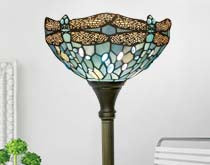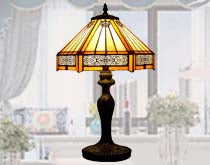Common Materials for Tiffany's Lamp Bases
When we step into a room, our attention is often captured by unique decorative items. Among them, Tiffany lamps, with their distinctive designs and vibrant glass shades, undoubtedly take center stage.
The origins of Tiffany lamps date back to the early 20th century, crafted by the brilliant artist Louis Comfort Tiffany. His designs were often inspired by the beauty of nature and abstract artistic patterns, and the Tiffany-style lamps capture these elements perfectly.

When investing in a quality Tiffany-style lamp, beyond the captivating shade, the base of the lamp plays a pivotal role.
Related reading: Where to Find Tiffany Floor Lamp Bases
The base of a lamp is its foundation of stability. Choosing a superior Tiffany lamp base is not just about the stability and safety of the fixture, but also about making the whole Tiffany lamp look more appealing.
I'm sure an ordinary table lamp base is not something you would use to match your fine Tiffany lamp shade. Except for emergencies. Such a beautiful Tiffany glass lamp should be matched with a high-quality lamp base.
Choosing the right base material ensures the lamp's longevity and harmonizes with the shade, perfecting the entire piece. Conversely, an ill-suited base might compromise the lamp's stability, potentially risking damage to the precious stained glass shade.
Common materials for Tiffany lamp bases include:
- Resin
- Zinc
- Bronze
- Brass
- Wood
- Ceramic
- Iron
When selecting a Tiffany lamp, the base material is of paramount importance. The choice of materials for Tiffany lamp bases is not only about the sturdiness and safety of the fixture, it is a key factor that directly shapes its unique beauty and value.
In the content of this article, we listed various materials of Tiffany lamp base, hope you choose the perfect Tiffany base by understanding these material properties.
Characteristics of Each Material
Resin
Resin bases are celebrated for their lightweight and versatility. This material is lightweight but mimics the look of stone, wood, or metal, making it really practical without sacrificing style. This makes resin an ideal choice for lamps that one might want to move around or reposition frequently. However, it might not be as robust as other materials and may show signs of wear or fading over time.
Zinc
Zinc offers an affordable material with a modern sheen and clean lines. Zinc matches perfectly with a wide range of lampshades, especially those designed with industrial or modern elements. Zinc is strong and corrosion-resistant, so it can be used for a long time and has a long lifespan.
Bronze
The corrosion-resistant properties of bronze ensure that the luminaire remains as beautiful as ever.
Its moderate weight gives the luminaire a firm foundation and prevents it from tipping over accidentally. Bronze exudes a sense of historical charm and classic beauty. Over time, it naturally forms a patina, enhancing its vintage appeal.
Brass
Brass can be polished to reveal an elegant golden sheen, perfectly complementing vintage-style shades. It's durable and resistant to everyday wear. Over time, its surface develops a rich patina. A Tiffany base made of brass, with its golden glow, harmonizes beautifully with the colorful glass shade, adding an extra touch of artistry.
Wood
Tiffany bases made of wood offer a natural ambiance. The inherent textures and colors of wood add a touch of nature's beauty to the lamp. If you own a nature-themed style Tiffany stained glass lampshade, Dragonfly Tiffany, Bird Tiffany, Butterfly Tiffany, and more. I think it would be very appropriate as well.
Moreover, wooden bases seamlessly blend with country or vintage home decor. Although wood requires periodic maintenance to retain its beauty, its natural durability ensures longevity.
Ceramic
Ceramic bases are unique and refined, featuring smooth surfaces and a plethora of colors. They add an artistic flair to the lamp and are also quite sturdy. The weight of ceramic provides good stability, ensuring your Tiffany lamp remains well-balanced. Additionally, ceramic's insulating properties make it apt for electrical fixtures.
Iron
Iron bases are sturdy and moderately weighted, making them ideal for modern and industrial-style homes. One might wonder if, over time, the iron base would rust.
While untreated iron might rust, with proper anti-rust treatments, iron bases can maintain their original beauty for a long time. Its toughness and durability allow it to withstand daily wear. Untreated iron might develop rust, but this can also add a unique charm to it. Compared to other materials, iron is often more affordable, offering a practical yet stylish choice for consumers.
Choosing the Base Material Based on Home Decor Style

Selecting the base material for a Tiffany lamp goes beyond stability and durability; it's also a significant component of home decor. The right base can amplify the overall home style, while a mismatch might make the lamp seem out of place.
Traditional Home Style: If your home emphasizes details, uses classic furniture, and boasts rich colors and textures, materials like bronze, brass, or wood can add a sense of history and classic elegance.
Modern Home Style: Modern home styles prioritize clean lines, neutral tones, and functionality. Bases made of zinc or iron, with their minimalistic and contemporary feel, can seamlessly integrate into modern decors.
Country or Vintage Style: Materials like wood or ceramic can infuse a country or vintage ambiance into the home.
Minimalist Style: Minimalism emphasizes minimal decor and functionality, often adopting neutral tones. Bases made of resin or iron might be more fitting.
If you're not particularly concerned about style and focus more on the visual appeal, read on.
Harmony Between Base Material and Overall Lamp Design
Consider Color: Ensure the base color complements the shade or opt for neutral tones to accommodate various colors.
Consider Texture: Materials like wood and ceramic have unique textures that might pair better with certain shades.
Consider Shape: The shape of the base should harmonize with the shade. For instance, a round shade might be better suited to a round or cylindrical base
Of course, when purchasing a Tiffany lamp, it usually comes as a set, including both the shade and the base.

Final words
Choosing the right base material can enhance your home decor style while ensuring the lamp's stability and longevity. When investing in a Tiffany lamp, don't overlook the significance of the base; it's equally vital. Remember, the best choice is the one that caters to your personal needs and complements your home decor style.
Most of the Tiffany-style lamps on the market use polyethylene as the lamp base material. For some of the more upscale styles, their lamp bases are made of zinc alloy to mimic the texture and look of bronze.
While these lamp bases vary in design, the quality of their manufacturing remains relatively consistent from supplier to supplier. But when it comes to the true value of a Tiffany lamp, it is undoubtedly given by its unique and beautifully crafted shade.
Related reading: How to Assemble Werfactory Vintage table lamps
FAQ
What are Tiffany lamp bases made of?
Authentic Tiffany Studios lamps have hollow bases, and they are made of pure bronze. There are a few examples of art pottery bases, though those are rare. When Tiffany Studios lamps were manufactured, bronze was expensive and hard to come by.
Are Tiffany lamps glass or plastic?
There's a common myth surrounding Tiffany items. Many assume they're made of plastic because of the sound they produce when tapped. But here's the truth: Genuine Tiffany lamps might sound like plastic when you give them a tap, but they're crafted from glass. So, the next time you come across a Tiffany lamp, remember this little tidbit before making any judgments.



























